Renovation of the facade of the building includes several stages: plastering, painting and other works. But before proceeding with the repair work, it is necessary to determine the nature of the destruction. For example, if a small crack is found in the wall, then experts recommend diagnosing it in order to determine the cause of the crack and prevent the appearance of new defects. Among the most common destruction of building facades, experts identify the following: cracks resulting from building shrinkage, as well as shedding of plaster, paint and the appearance of salt deposits.
Facade repair technology
Any repair work begins with preparation. First, you need to clean the facade of the building from the old coating, if necessary, repair the eaves, ebb and drainage system, tap the existing tiles. At this stage of the preparatory work, you can determine the nature of the damage, as well as immediately outline a work plan. At the same time, it is necessary to resolve the issue of insulation of the building facade and to waterproof all existing joints.
According to the technology of repairing the facades of buildings, after determining the nature of the damage, it is worth deciding how the repair work will be carried out - with the involvement of specialists or independently. If the building is multi-storey, then it is better not to hesitate and entrust the work to the builders who use the method of industrial mountaineering to repair the facade of the building. This will allow not only to perform high-quality plastering of the surface, but also to paint the entire surface of the building much faster. This method allows you to save money and time for the construction of scaffolding or the use of an aerial platform.
Regardless of who will be engaged in the repair of the facade, you should first prepare the area and install a fence. This is especially true if there is a sidewalk, carriageway, or parking located directly in front of the facade.
In order not to damage the tides and windows, it is necessary to protect such places with construction film.
Repair stages
Facade repair work is a long and laborious process, therefore it is necessary to familiarize yourself with the sequence of repair work in advance.
- Preparatory work (inspection of damage to the facade of the building).
- Cleaning of facades from debris and old plaster.
- Plastering works. Applying a layer of plaster will level the surface and fill the existing small gaps. If the cracks in the building are deep, then they are pre-filled with polyurethane foam, and then covered with a layer of plaster. Crevices can be formed for many reasons, respectively, and methods for eliminating them may be different. Depending on this, experts select the building material individually. If a small area is damaged, then simply plaster the wall. In the case when a large area of the facade is damaged, then it becomes necessary to use a mesh-netting (a reinforcing layer on which plaster will be applied).
- Surface treatment with primer mixtures. This is necessary in order for the paint to adhere well to the surface. If you do not pre-treat the facade of the building with a primer, then the paint will not last long, and over time, under the influence of atmospheric precipitation, it can break off. In addition, the paint consumption will be high.
- Painting the facade of a building is the final stage of renovation work. The process is laborious, but from the outside it seems that painting the facade of a building is easy. But in fact, in order to paint the facade of a building beautifully, you need to choose the appropriate tool and apply the paint in stages. It should be borne in mind that the first layer of paint will be pale. In order for the surface to become homogeneous, without streaks, it is necessary to have some work experience.
Facade repair photo:
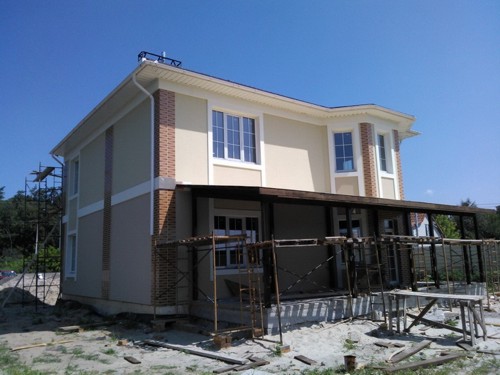

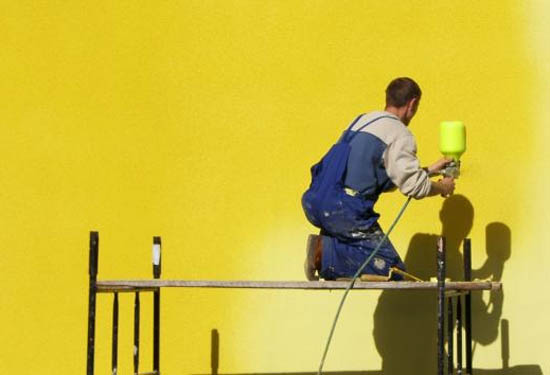
Overhaul of facades
Overhaul of buildings, as opposed to cosmetic, requires certain skills and appropriate training.
Renovation of the facade of a building is divided into two types:
- Cosmetic.
- Capital.
When performing a major overhaul, you must adhere to the following plan:
- Performing diagnostics of the condition of the facade of the building in order to determine the scope of work.
- Preparation - cleaning the surface from paint, removing a layer of plaster.
- Thermal insulation and waterproofing of joints between panels, surface treatment with a primer mixture, plastering.
- Finishing works - facing the facade of the building with decorative materials (ceramic tiles, marble, decorative stone, siding), plastering, painting the building.
- Surface treatment with a water-repellent mixture (hydrophobization).
- Repair of gutters, gutters, air ducts, ebb and flow and ventilation.
Features of the renovation of the facade of the building include certain rules. So, in order to remove the old paint from the surface, it is necessary to apply a special composition to the surface, which will soften it and allow faster and better paint removal, even by hand. If necessary, the surface can be rinsed with a jet of water under pressure, thus, the surface is cleaned of fine paint residues, dirt and dust. This technology will allow you to remove several layers of old paint at the same time.
When overhauling the facade of a building, it is often necessary to remove the remains of cement mortar in the masonry. An aqueous solution prepared on the basis of a special cleaning powder removes old cement well. Then the surface is thoroughly rinsed with water.
Often, overhaul of building facades cannot be performed without preliminary surface treatment with antifungal compounds. In some cases, mechanical cleaning may be required.
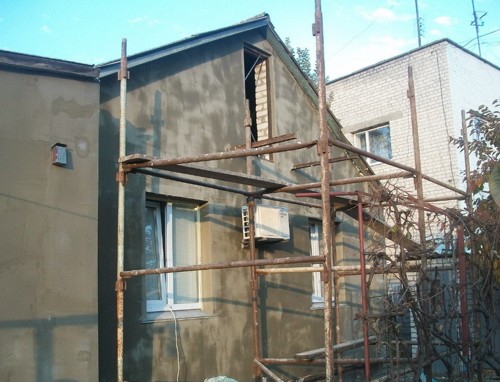
Facade plaster repair
Damaged plaster, which has begun to crumble, can be restored on your own. Let's take a closer look at how to independently plaster the facade of a building.
For work, you need to prepare the following tools and materials:
- putty mixture;
- surface primer;
- hammer;
- container for mixing the solution;
- a plastic container or container with a spray bottle;
- wire mesh (netting);
- Master OK;
- hard brush;
- putty knife;
- bucket with water.
If in cold weather the first signs of destruction of the plaster of the facade of the building were found, which were not immediately eliminated, then during several cold months the damage will only increase.
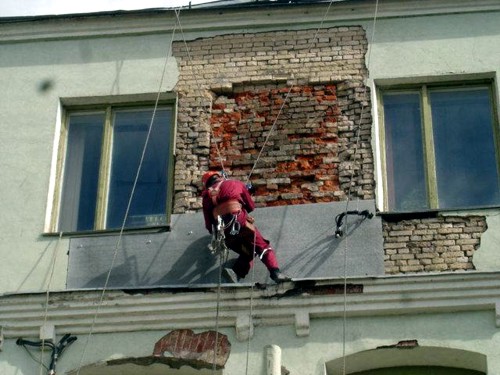
In the photo you can see a façade defect that arose as a result of moisture and frost. The plaster on the building's façade has chipped off.
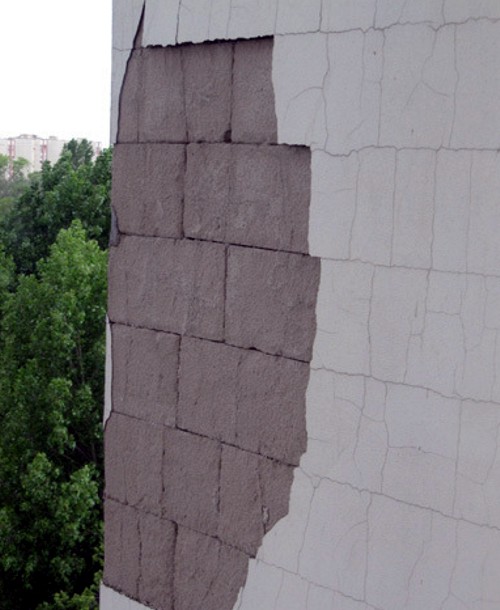
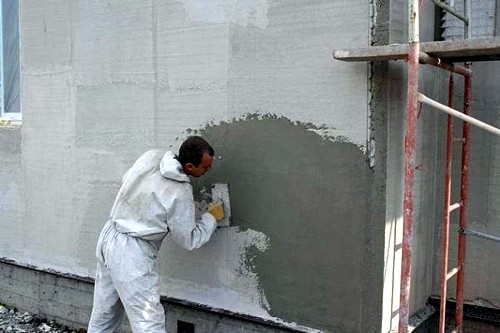
As soon as a stable temperature is established (during frost it is undesirable to work with a solution), it is necessary to urgently repair the damage so that the brickwork of the building does not collapse.
How to repair the plaster of the building facade:
- With the help of construction tools, it is necessary to smooth out the surface of the facade and the seams.
- Areas with damaged plaster must be cleaned off, and the place must be filled with a bonding layer - a plaster solution.
- In order for all the work to be completed in a short time, you can use ready-made solutions. It will be good to keep the plaster solution prepared by yourself. A universal cement mortar (it is also used for laying bricks) is prepared from water, sand and cement. The sand should be taken clean and not too fine (the size of grains of sand is up to 2 millimeters), preferably river sand. Before mixing with cement, it is advisable to sift it through a sieve to separate small pebbles, pieces of earth and other debris. The finished solution retains its plasticity from 1.5 to 5 hours. The time will depend on the quality of the cement and the proportions of the mortar. The strength of the solution depends on the amount of sand - the less it is, the stronger the solution will be and vice versa. For the preparation of the solution, cement of the M25, M50 and M75 brands is used.
- After applying the cement mortar, dust and cement residues must be removed with a stiff brush, and the surface must be well moistened with water. It is necessary to moisten the surface of the building for better adhesion of the plaster to the base.
- Now it remains to apply the solution a second time. In consistency, it will be more liquid than the first. You can level the surface using special construction tools - a rule or a trowel when the mortar starts to set.
- At least 24 hours should elapse between each applied layer of cement mortar.
- After completing the cement masonry, you can paint the surface or apply a layer of decorative plaster.
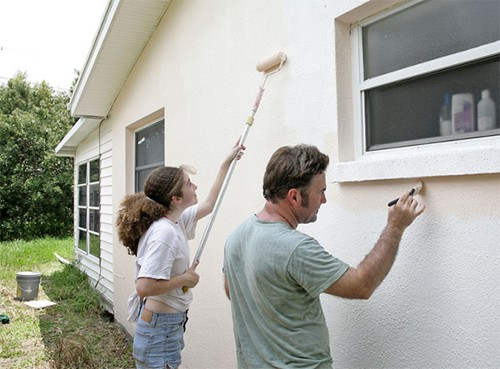
How to repair the facade of a building, see the video:




